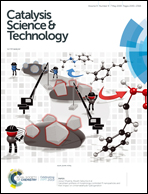Real-time regulation of catalysis by remote-controlled enzyme-conjugated gold nanorod composites for aldol reaction-based applications†
Abstract
Remote-controlled nanomaterials, used to regulate rapid conversion of light energy into internal energy, are an emerging technology for achieving real-time control of enzymatic and catalytic industrial processes. One means of achieving control is through alteration of the photothermal ability of plasmonic nanostructures to deliver internal energy to enzymes in order to regulate catalytic rates. Such smart systems design is applicable to fields of enzymology, biological engineering, and chemical synthesis. Here, we fabricate enzyme-conjugated gold nanorod composites (EGCs) via self-assembly to enhance enzymatic activity, reusability, and thermal stability of mesophilic, thermophilic, and hyperthermophilic enzymes. Using the photothermal effect of EGCs to convert near-infrared (NIR) laser irradiation to internal energy, rapid elevation of local temperature and enzyme activity and real-time control over the reaction are achieved. We also demonstrate that enzymes with higher optimal temperatures are especially suitable for use in the remote-controlled nanobiocatalytic system. Ultimately, the photothermal effect of EGCs exhibits excellent promiscuity, catalytic efficiency (8-fold higher), and yield (99%) and achieves aldol addition within 30 min. Thus, EGCs possess great potential benefits for industrial applications and can be incorporated into real-time enzyme catalysis systems that are regulated using remote-controlled nanobiocatalytic strategies.



 Please wait while we load your content...
Please wait while we load your content...